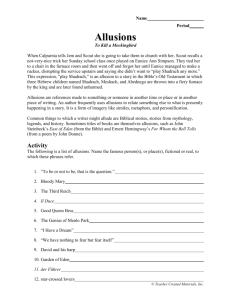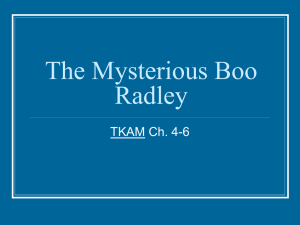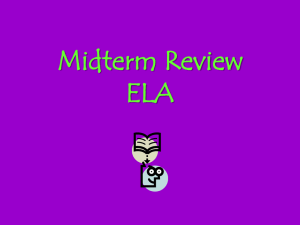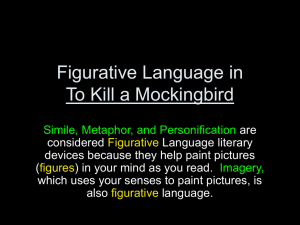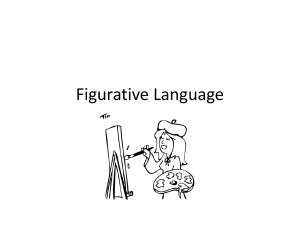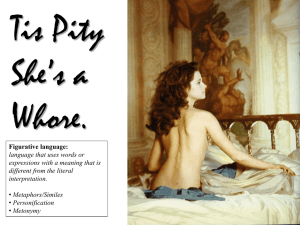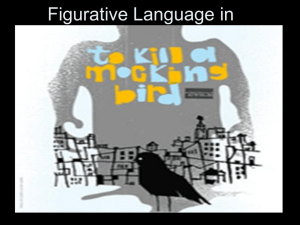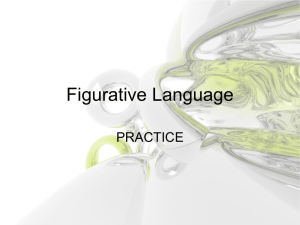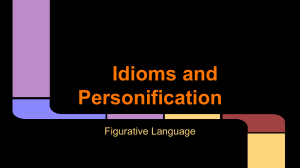Elements of Literature
advertisement
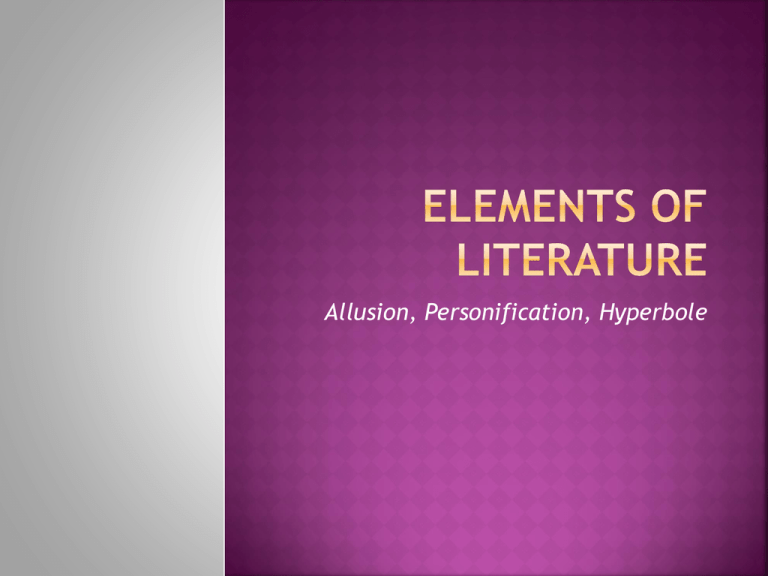
Allusion, Personification, Hyperbole Allusions are references made to something or someone in another time or place or in another piece of writing. An author frequently uses allusions to relate something else to what is presently happening in a story. It is a form of imagery like similes, metaphors, or personification. Common things to which a writer might allude are Biblical stories, stories from mythology, legends, and history. Sometimes titles of books are themselves allusions, such as John Steinbeck’s East of Eden (from the bible) and Ernest Hemingway’s For Whom the Bell Tolls (from a poem by John Donne). When Calpurnia tells Jem and Scout she is going to take them to church, Scout recalls a not-very-nice trick her Sunday class one played on Eunice Ann Simpson. They tied her to a chair in the furnace room and then went off and forgot her until Eunice managed to make a ruckus, disrupting the service upstairs and saying she didn’t want to “play Shadrach any more.” This expression, “play Shadrach,” is an allusion to a story in the Bible’s Old Testament in which three Hebrew children named Shadrach, Meshach, and Abednego are thrown into a fiery furnace by the king and are later found unharmed. “Dill had seen Dracula, a revelation that moved Jem to eye him with the beginning of respect” (Lee 9). • This is a reference to the 1931 movie, Dracula, starring Bela Lugosi. • “…to eye him” in this context means to judge someone with a new perspective. 1.“To be or not to be, that is the question.” 2.The Third Reich 3.“I Have a Dream” 4.“We have nothing to fear but fear itself.” 5.Garden of Eden Personification is when you assign the qualities of a person to something that isn't human or, in some cases, to something that isn't even alive. There are many reasons for using personification. It can be used as a method of describing something so that others can understand. It can be used to emphasize a point. It is a commonly favored literary tool, and you may in fact use personification without even knowing it. 1. The stars danced playfully in the moonlit sky. 2. The run down house appeared depressed. 3. The first rays of morning tiptoed through the meadow. 4. She did not realize that opportunity was knocking at her door. 5. He did not realize that his last chance was walking out the door. 6. The bees played hide and seek with the flowers as they buzzed from one to another. 1. “The remains of a picket drunkenly guarded the front yard” (Lee 10). 2. “The misery of the house began many years before Jem and I were born’ (Lee 11). 3. “Mr. Radley’s older son lived in Pensacola; he came home at Christmas, and he was one of the few people we ever saw enter or leave the place. From the day Mr. Radley took Arthur home, people say the house died” (Lee 14-15). 4. “The house was the same, droopy and sick, but as we stared down the street we thought we saw an inside shutter move. Flick. A tiny, almost invisible movement and the house was still” (Lee 19). • What is left of the fence around the Radley house stands like someone who has had too much to drink. • The sadness of the place has a history. • Giving the house human characteristics sheds additional light on the author’s characterization of the people who live in the house. 1. The wind howled its mighty objection. 2. The snow swaddled the earth like a mother would her infant child. 3. The river swallowed the earth as the water continued to rise higher and higher. 4. Time flew and before we knew it, it was time for me to go home. 5. The ocean waves lashed out at the boat and the storm continued to brew. A hyperbole is an extreme exaggeration used to make a point. It is like the opposite of “understatement.” It is from a Greek word meaning “excess.” Hyperboles can be found in literature and oral communication. They would not be used in nonfiction works, like medical journals or research papers; but, they are perfect for fictional works, especially to add color to a character or humor to the story. Hyperboles are comparisons, like similes and metaphors, but are extravagant and even ridiculous. 1. “I’ve told you a million times” 2. “It was so cold, I saw polar bears wearing jackets” 3. “She is so dumb, she thinks Taco Bell is a Mexican phone company” 4. I am so hungry I could eat a horse. 5. I have a million things to do. 6. I had to walk 15 miles to school in the snow, uphill. 7. I had a ton of homework. 8. If I can’t buy that new game, I will die. “The world's endin', Atticus! Please do something-!” I dragged him to the window and pointed (Lee 86) "Well how'd you feel if you'd been shut up for a hundred years with nothin' but cats to eat? I bet he's got a beard down to here".(Lee 62). • Scout’s surprise at seeing snow made her think the impossible had occurred. • Dill’s imagination offered an unrealistic passage of time, demands of an appetite, and growth of facial hair! 1. He is as skinny as a toothpick. 2. This car goes faster than the speed of light. 3. That new car costs a bazillion dollars. 4. We are so poor; we don’t have two cents to rub together. 5. That joke is so old, the last time I heard it I was riding on a dinosaur. 6. They ran like greased lightning. 7. He's got tons of money. 8. You could have knocked me over with a feather. 9. Her brain is the size of a pea. 10.He is older than the hills. • Allusions are references made to something or someone in another time or place or in another piece of writing. • Personification is when you assign the qualities of a person to something that isn't human or, in some cases, to something that isn't even alive. • A hyperbole is an extreme exaggeration used to make a point. • He's got tons of money. • “I was surprised his nose was not growing like Pinocchio’s.” • You could have knocked me over with a feather. • The popcorn leapt out of the bowl. • When the DVD was on sale, it flew off the shelves. • “I thought the software would be useful, but it was a Trojan Horse.” • The waffle jumped up out of the toaster. • Her brain is the size of a pea. • I tripped because the curb jumped out in front of me. • He is older than the hills. • Time creeps up on you.

